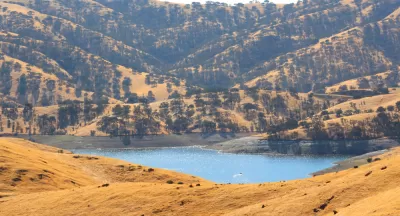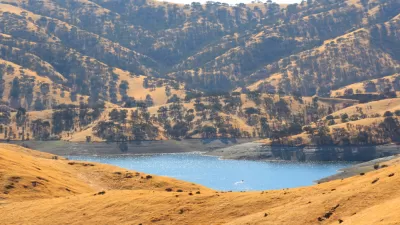Missed in the non-stop coronavirus coverage of the past several months: plans to build a massive reservoir in North California have been scaled back dramatically.

Paul Rogers reports: "An ambitious plan to build the largest new reservoir in California in 40 years to supply water to homes and businesses from the Bay Area to Los Angeles, along with Central Valley farmers, is being scaled back considerably amid questions about its $5 billion price tag and how much water it can deliver."
The Sites Reservoir, as the future reservoir is known, is planned for ranch land in Colusa County, about 70 miles north of Sacramento, and funded by the largest chunk of Proposition 1 money awarded by the California Water Commission in 2018. Despite that big chunk of funding, the project still hasn't found all the money it needs, so the Sites Project Authority is revising the plan. Rogers explains the changes:
Under the new approach, the price tag will be cut roughly 40% from $5.1 billion to $3 billion. The reservoir’s size will shrink from 1.8 million acre feet to 1.5 million acre feet. Plans to build an 18-mile pipeline east to the Sacramento River to fill the reservoir were dropped in favor of using existing canals. A hydro-power pumping station was cut. And significantly, the amount of water the reservoir is expected to deliver on average, known as the “annual yield,” was cut in half from 505,000 acre feet to 243,000 acre feet.
The article includes more details about what it will take to get the project across the finish line.
FULL STORY: Massive Northern California reservoir project scaled back to reduce costs

Alabama: Trump Terminates Settlements for Black Communities Harmed By Raw Sewage
Trump deemed the landmark civil rights agreement “illegal DEI and environmental justice policy.”

Planetizen Federal Action Tracker
A weekly monitor of how Trump’s orders and actions are impacting planners and planning in America.

The 120 Year Old Tiny Home Villages That Sheltered San Francisco’s Earthquake Refugees
More than a century ago, San Francisco mobilized to house thousands of residents displaced by the 1906 earthquake. Could their strategy offer a model for the present?

In Both Crashes and Crime, Public Transportation is Far Safer than Driving
Contrary to popular assumptions, public transportation has far lower crash and crime rates than automobile travel. For safer communities, improve and encourage transit travel.

Report: Zoning Reforms Should Complement Nashville’s Ambitious Transit Plan
Without reform, restrictive zoning codes will limit the impact of the city’s planned transit expansion and could exclude some of the residents who depend on transit the most.

Judge Orders Release of Frozen IRA, IIJA Funding
The decision is a victory for environmental groups who charged that freezing funds for critical infrastructure and disaster response programs caused “real and irreparable harm” to communities.
Urban Design for Planners 1: Software Tools
This six-course series explores essential urban design concepts using open source software and equips planners with the tools they need to participate fully in the urban design process.
Planning for Universal Design
Learn the tools for implementing Universal Design in planning regulations.
Clanton & Associates, Inc.
Jessamine County Fiscal Court
Institute for Housing and Urban Development Studies (IHS)
City of Grandview
Harvard GSD Executive Education
Toledo-Lucas County Plan Commissions
Salt Lake City
NYU Wagner Graduate School of Public Service





























